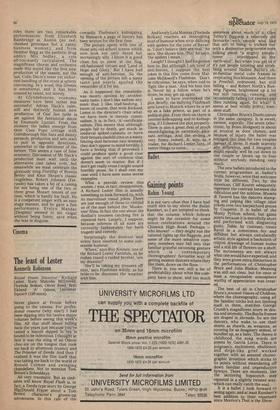Ballet
Gaining points
Robin Young
It is not very often that I have had much nice to say about the Ballet Rambert, so I am tempted to think that the column which follows might be the occasion for some minor celebrations around the Chiswick High Road. Perhaps — who knows? — they might run the tattered tights up the flagpole, and some of the more sensitive company members may fall into that familiar grateful swooning gesture which is contemporary choreographers' favourite way of getting modern dancers where they like them, down on the floor.
There is, you see, still a lot of predictability about what the company have to show, and too much sameness about much of it. Glen Tetley's Ziggurat a relatively old favourite with people who like that sort of thing, is tricked out with a distinctive programme note talking about "a mighty temple tower . . . worshipped as the earth-soul", but when you get to it it's just people tottering and scrab bling around Nadine Baylis's ohso-familiar metal cube frames to crepitating Stockhausen. And there is Freefall, redressed, but still falling — and Robert North's Run ning Figures, brightened up a lot but still running, running, and occasionally falling (of course) and then running again, So what? It seems at best mildly pretty, transient stuff.
Christopher Bruce's Duets comes in the same category. It is sweet, earnest, soporific. The score (elec tronic, by Brian Hodgson) is about as musical as door chimes, and bec4use of injury the ballet was j5e44ged_ this time for two couples tItgdipf.three. It made scarcely apyt,,qhfrence, and I imagine it roight equally well be cut down to one couple or blown up to four without anybody minding very much.
The new ballets introduced to the current programmes at Sadler's Wells, however, were that welcome little bit different. Two by the American, Cliff Keuter adequately represent the contrast between the ridiculous and the sublime. Musete di Taverni has the dancers stamping and yelping like village idiot yokels over two harpsichord pieces by Couperin. It is ballet of the Monty Python school, but gains points because it is mercifully short and performed with disgusting gusto. Table, by contrast, treats Ravel in a sometimes fey and diffident but always calculatedly artistic style against a backcloth of crayon drawings of human nudes and a still life of flowers on a shelf. The movements are not always what one would have expected, and they were given extra distinction in the performances of Christopher Bruce and Julia Blaikie. Meaning was still not clear, but for once at least a recognisable atmosphere worthy of appreciation was created.
The best of all is Christopher Bruce's Ancient Voices of Children, where the choreography, using all the familiar tricks but not limiting itself to them, matches George Crumb's magnificent score in drama and intensity. The Baylis frames are draped in shrouds. So are the dancers, who wake to use their sheets as shawls, as weapons, as covering for an imaginary animal, or bundled up, as a baby. The theme is childhood, the sung words are poems by Garcia Lorca. There is poignancy, excitement, ebullience, and dirge-like grief worked ,together with an assured choreographic invention which sticks to its points without meandering off down familiar and unproductive byways. There are moments, like• , the skittering hopscotch step repeated in a slightly twisted way, which can really catch the soul.
It is a ballet I look forward to seeing again, and at least Rambert's best addition to their repertoire since Morrice's That is the Show.


































 Previous page
Previous page